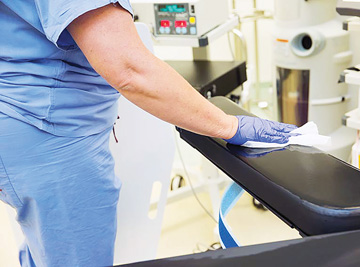ATP testing involves zigzagging a swab over a 4-inch by 4-inch surface area and placing the swab into a luminator, which tests for the presence of ATP and provides the results in relative light units (RLUs). ATP is the molecule cells use to
survive and its presence indicates microbial activity — and shows the tested surface had not been decontaminated. Ms. Hornbeck used the evidence-based threshold of 100 RLUs to determine the cleanliness of OR surfaces; areas that
exceeding that threshold were recleaned and retested until a “clean” reading was achieved.
The luminator automatically inputs the results of each test into an electronic database, which clinical managers use to track and monitor results and identify areas of needed improvement. ATP testing is a way to identify cleaning practices
based on empirical data and present the results to staff.
Ms. Hornbeck also posts the results on quality improvement bulletin boards and discusses them at departmental meetings. The key, she says, is to keep staff informed of gaps in the cleaning process so they can address and correct them in real
time.
Ms. Hornbeck says trace amounts of bioburden can accumulate on surfaces throughout successive room turnovers despite staff turning over the rooms according to the facility’s surface cleaning protocols. That’s why instead of testing
the staff’s cleaning performance between every case, she has staff swab surfaces after the last procedure to test the cumulative results of the staff’s cleaning efforts.
“Testing should be as unobtrusive as possible because fast turnover times are important in high-volume facilities,” says Ms. Hornbeck. “Results can be obtained in a matter of minutes, but we didn’t feel it was practical
to ask staff to swab surfaces throughout the day.”
It’s also important to keep staff on their toes. To ensure surgical staff members can’t focus on cleaning where they know they’ll be tested, swab five randomly selected surfaces from a list of high-touch and potentially problematic
areas. At Northside Hospital, that list includes back tables, computer keyboards, Mayo stands, brake handles on the surgical bed and knobs on anesthesia machines.
Ms. Hornbeck suggests making cleaning improvement projects staff-driven initiatives instead of top-down mandates. That way, the staff members who are doing the cleaning are engaged in the process and feel empowered to do it correctly. It’s
also impossible to directly supervise the cleaning of every OR between every case, so staff must take full responsibility in ensuring all surfaces are covered during turnovers.
Staff are motivated by the results of ATP testing if the findings are presented in the context of being accountable for patient safety, according to Ms. Hornbeck. She found the need to retest and reclean surfaces decreased in orthopedic ORs
following the friction-focused educational efforts.
The staff-driven testing initiative at Northside Hospital has been expanded since being launched in the ORs; staff now test other high-touch surfaces throughout the perioperative department. “Intrinsic motivation was an important
factor is this initiative,” says Ms. Hornbeck. “Our team has taken ownership in the process improvement, and that’s been awesome to see.”
.svg?sfvrsn=be606e78_3)

.svg?sfvrsn=56b2f850_5)